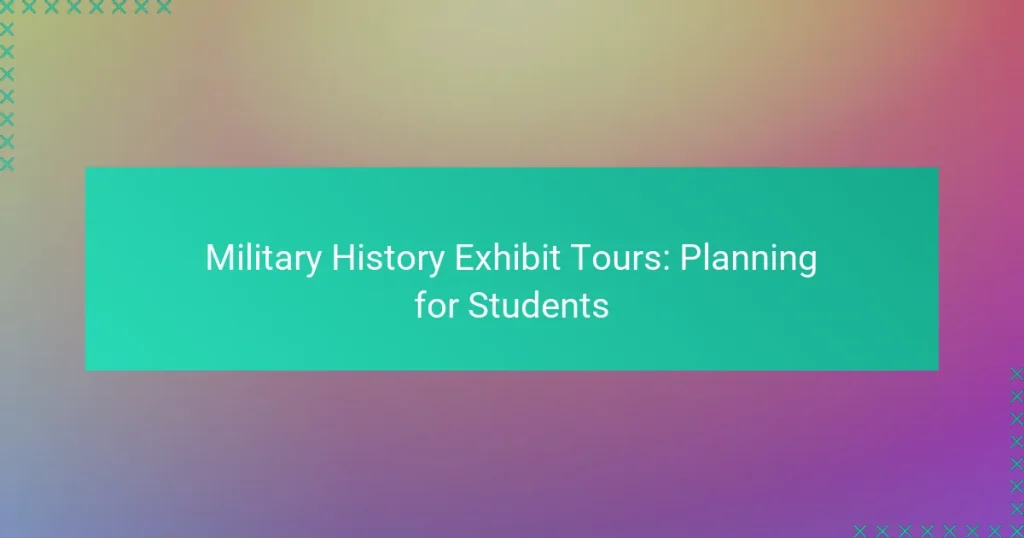Planning military history exhibit tours for students in the US requires careful selection of relevant exhibits and clear educational goals. By organizing transportation and collaborating with local museums, educators can create enriching experiences that enhance students’ understanding of historical events and artifacts.
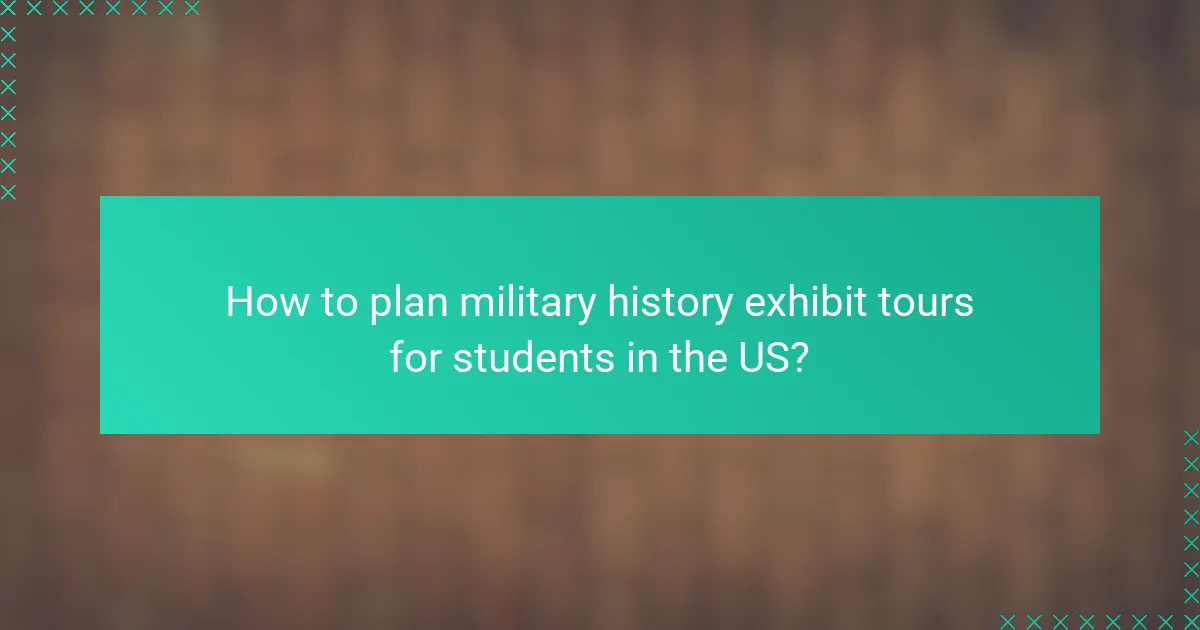
How to plan military history exhibit tours for students in the US?
Planning military history exhibit tours for students in the US involves selecting relevant exhibits, defining educational goals, managing costs, organizing transportation, and collaborating with local museums. A well-structured approach ensures an enriching experience that aligns with educational standards.
Identify key military history exhibits
Start by researching military history exhibits that are accessible and relevant to your students’ curriculum. Consider visiting renowned institutions such as the National WWII Museum in New Orleans or the Smithsonian National Museum of American History in Washington, D.C. These venues often feature interactive displays and artifacts that engage students effectively.
Compile a list of exhibits that cover various aspects of military history, such as wars, battles, and the experiences of soldiers. Prioritize those that align with your educational objectives to ensure a cohesive learning experience.
Establish educational objectives
Define clear educational objectives for the tour to maximize its impact. Objectives might include understanding the causes and consequences of specific conflicts, analyzing military strategies, or appreciating the sacrifices made by service members. Tailor these goals to the age and knowledge level of your students.
Incorporate hands-on activities or discussions that encourage critical thinking and reflection on the material presented at the exhibits. This approach fosters deeper engagement and retention of knowledge.
Determine budget and funding sources
Establish a budget that covers all aspects of the tour, including admission fees, transportation, meals, and any additional materials. Costs can vary significantly based on the location and size of the group, so it’s essential to plan accordingly.
Explore funding sources such as school budgets, grants, or local community organizations that support educational initiatives. Consider organizing fundraising activities to help offset costs and make the tour more accessible for all students.
Coordinate transportation logistics
Plan transportation logistics well in advance to ensure a smooth journey. Depending on the distance, options may include school buses, public transportation, or charter services. Ensure that the chosen mode of transport is safe and comfortable for students.
Communicate the itinerary clearly to students and parents, including departure and arrival times, as well as any necessary guidelines for behavior during travel. This preparation helps set expectations and minimizes disruptions.
Engage with local military museums
Establish connections with local military museums to enhance the educational experience. Many museums offer guided tours, workshops, or special programs designed for student groups. Engaging with museum staff can provide valuable insights and resources tailored to your objectives.
Consider arranging pre-visit meetings or virtual sessions with museum educators to discuss the exhibits and how they can best support your learning goals. This collaboration can enrich the tour and provide students with a more immersive experience.
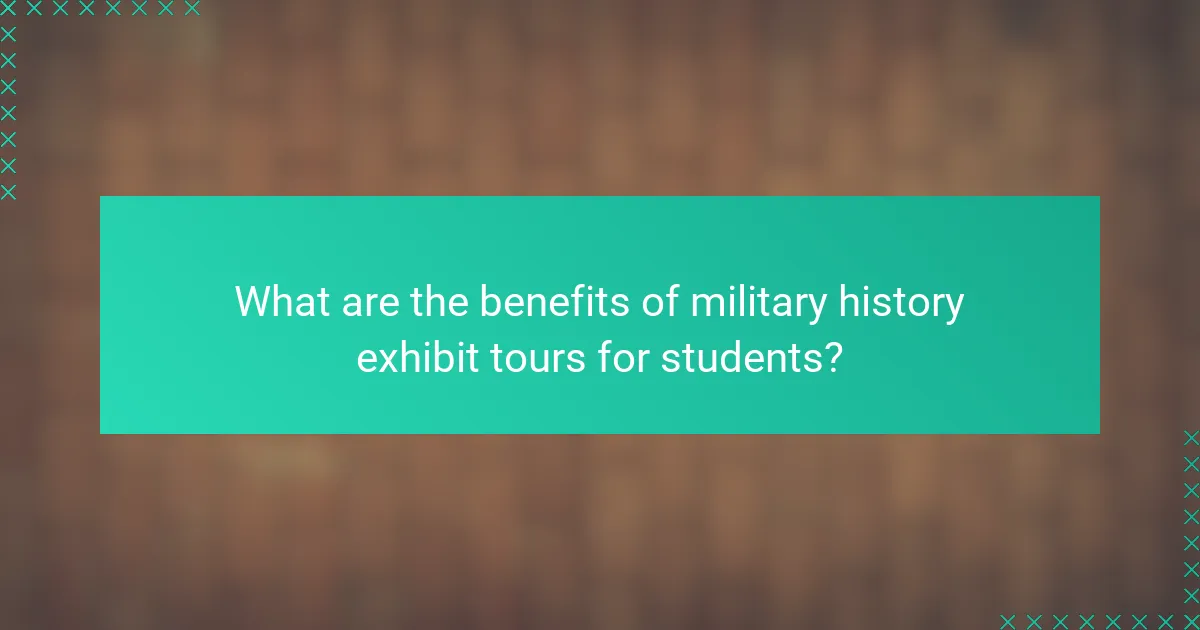
What are the benefits of military history exhibit tours for students?
Military history exhibit tours provide students with a unique opportunity to engage with historical events and artifacts, enhancing their understanding of the past. These tours foster critical thinking, teamwork, and collaboration skills, making learning more interactive and impactful.
Enhances historical understanding
Military history exhibit tours immerse students in the context of significant events, allowing them to see artifacts and displays that bring history to life. By interacting with exhibits, students can better grasp the complexities of military conflicts and their consequences on society.
For example, a tour of a World War II exhibit may include personal stories, uniforms, and weaponry, which help students connect emotionally and intellectually with the material. This experiential learning approach deepens their comprehension of historical timelines and causes.
Promotes critical thinking skills
Engaging with military history exhibits encourages students to analyze and interpret information critically. They learn to question narratives, evaluate sources, and understand different perspectives on historical events.
During a tour, students might be prompted to discuss the motivations behind military decisions or the impact of war on civilian populations. This kind of dialogue fosters analytical skills that are essential for academic success and informed citizenship.
Encourages teamwork and collaboration
Military history tours often involve group activities that require students to work together, fostering teamwork and collaboration. Students may be assigned tasks, such as researching specific artifacts or presenting findings to their peers.
These collaborative efforts not only enhance their social skills but also teach them the value of diverse viewpoints. By discussing and sharing insights, students learn to appreciate the importance of cooperation in understanding complex historical narratives.

What are the best military history exhibits to visit?
Some of the best military history exhibits include the National WWII Museum in New Orleans, the Smithsonian National Museum of American History in Washington, D.C., and the USS Midway Museum in San Diego. Each of these locations offers unique insights into different aspects of military history, making them valuable for educational tours.
National WWII Museum in New Orleans
The National WWII Museum is a comprehensive tribute to the American experience during World War II. It features immersive exhibits, personal stories, and artifacts that bring history to life, making it a must-visit for students interested in this pivotal conflict.
Consider scheduling a guided tour to enhance the experience, as knowledgeable guides can provide context and answer questions. The museum also offers educational programs tailored for students, which can be beneficial for group visits.
Smithsonian National Museum of American History in Washington, D.C.
The Smithsonian National Museum of American History houses a vast collection of military artifacts, including uniforms, weapons, and historical documents. This museum provides a broader context of American history, showcasing how military events shaped the nation.
When planning a visit, check for special exhibitions or events that may coincide with your trip. The museum offers free admission, making it an accessible option for student groups. Be sure to allocate enough time to explore the various exhibits thoroughly.
USS Midway Museum in San Diego
The USS Midway Museum is located on a historic aircraft carrier and offers a unique perspective on naval aviation and military operations. Visitors can explore the ship, view aircraft, and participate in interactive exhibits that highlight life aboard a carrier.
For a more engaging experience, consider booking a guided tour led by veterans who served on the Midway. This personal touch can provide invaluable insights and stories that enhance the learning experience for students. Admission fees are reasonable, and discounts may be available for groups.
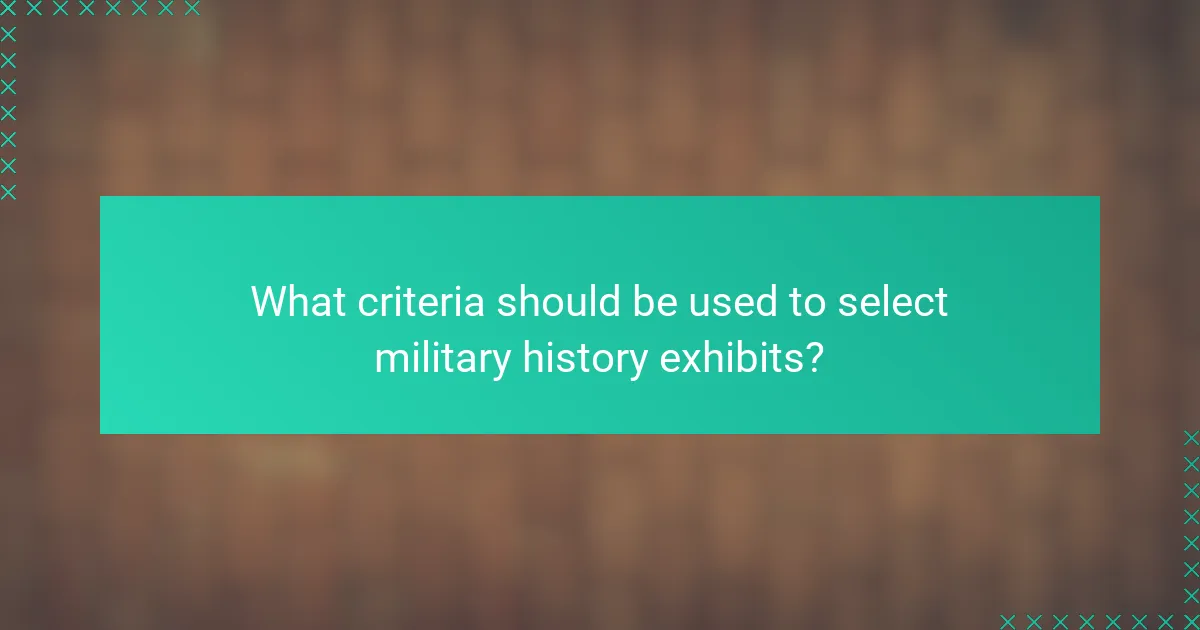
What criteria should be used to select military history exhibits?
Selecting military history exhibits for student tours should focus on relevance, accessibility, and engagement. These criteria ensure that the exhibits not only align with educational goals but also cater to diverse learning needs and foster an interactive learning environment.
Relevance to curriculum standards
When choosing military history exhibits, consider how well they align with local curriculum standards. Exhibits should cover key historical events, figures, and themes that are part of the educational framework, such as wars, military strategies, and their impacts on society.
For example, if a curriculum emphasizes World War II, selecting an exhibit that highlights significant battles or the role of technology in warfare would be beneficial. This alignment helps reinforce classroom learning and provides context to theoretical knowledge.
Accessibility for students
Accessibility is crucial when selecting military history exhibits for students. Ensure that the venue is physically accessible for all students, including those with mobility challenges. This may involve checking for ramps, elevators, and appropriate seating arrangements.
Additionally, consider the cognitive accessibility of the exhibits. Materials should be available in various formats, such as audio guides or braille, to accommodate different learning styles and needs. This inclusivity enhances the overall educational experience for every student.
Interactive and engaging experiences
Interactive exhibits can significantly enhance student engagement during military history tours. Look for exhibits that offer hands-on activities, simulations, or multimedia presentations that allow students to actively participate in their learning.
For instance, an exhibit that includes virtual reality experiences of historical battles can captivate students’ attention and deepen their understanding. Engaging formats not only make learning enjoyable but also help students retain information more effectively.
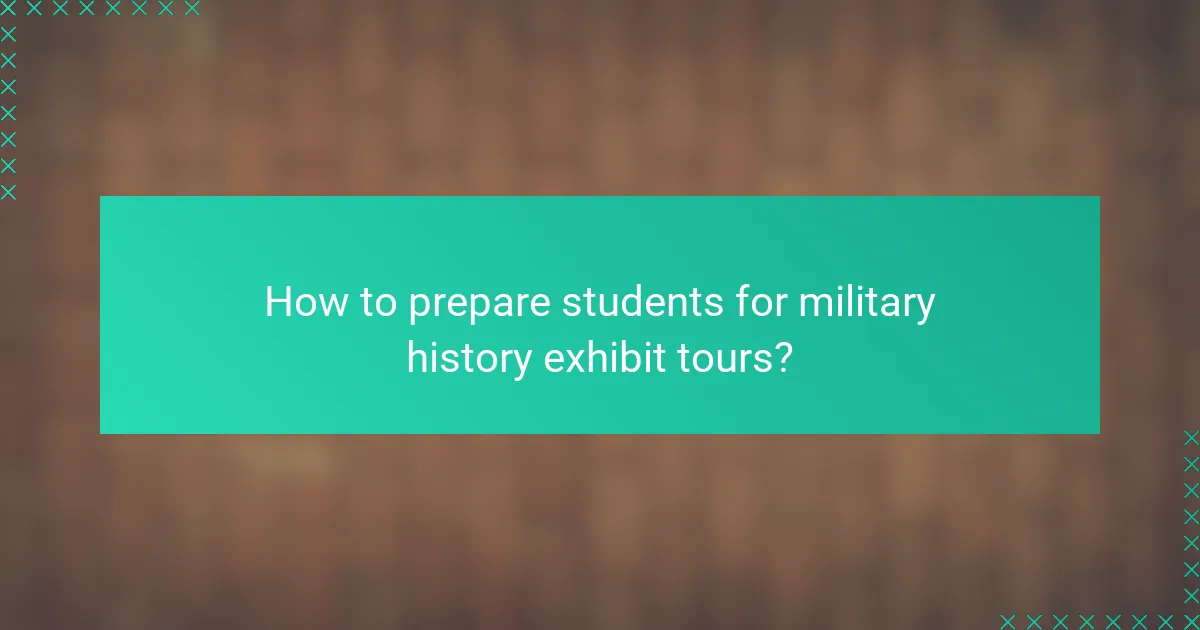
How to prepare students for military history exhibit tours?
Preparing students for military history exhibit tours involves providing them with background knowledge and practical guidance. This ensures they can engage meaningfully with the exhibits and enhance their learning experience.
Research the Exhibits
Before the tour, students should familiarize themselves with the specific exhibits they will visit. This can include reading about the historical context, key figures, and significant events represented. Providing a list of resources, such as books, articles, or documentaries, can help students gain a solid understanding.
Encourage students to focus on particular themes or artifacts that interest them. This targeted approach can lead to more engaging discussions during the tour and help them connect the exhibits to broader historical narratives.
Discuss Tour Etiquette
Proper etiquette during the tour is crucial for a respectful and educational experience. Remind students to be quiet while others are speaking, to ask questions at appropriate times, and to avoid touching artifacts unless permitted. Discussing these behaviors beforehand helps set expectations.
Additionally, encourage students to take notes or sketch their favorite exhibits. This practice not only aids retention but also fosters a deeper appreciation for the material presented.
Prepare Questions
Students should prepare thoughtful questions to ask during the tour. These can range from inquiries about specific artifacts to broader questions about the historical implications of the exhibits. Having questions ready encourages active participation and critical thinking.
Consider organizing a pre-tour session where students can brainstorm and share their questions. This collaborative effort can lead to richer discussions and a more engaging experience during the tour.
Logistics and Timing
Planning the logistics of the tour is essential for a smooth experience. Confirm the date, time, and duration of the visit, and ensure that transportation arrangements are in place. Aim to arrive early to allow time for any unforeseen delays.
Review the exhibit schedule and allocate time for each section. This helps students manage their time effectively and ensures they can explore all areas of interest without feeling rushed.
